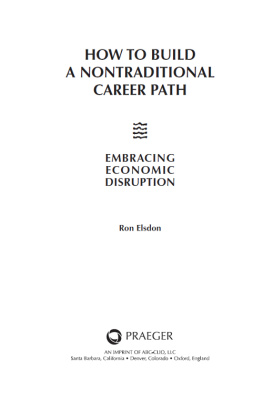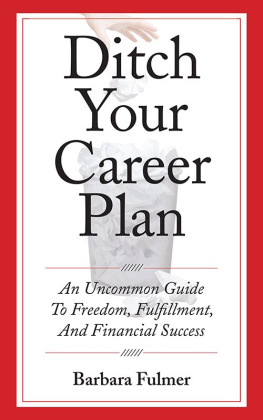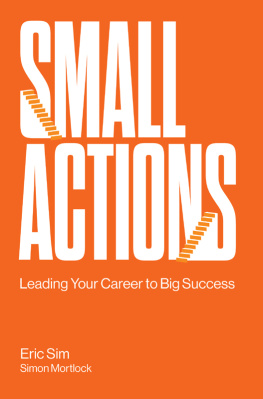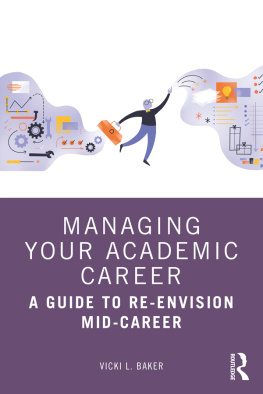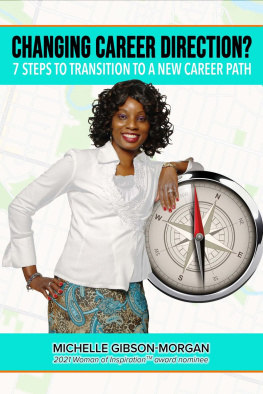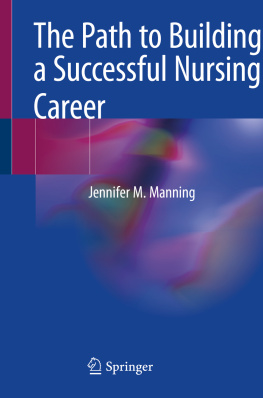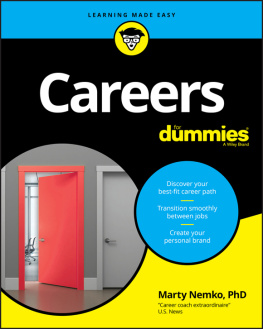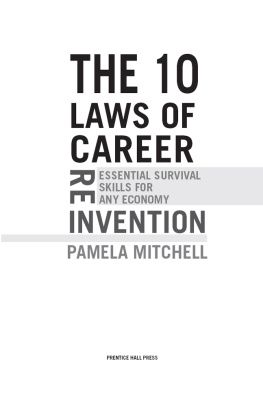
Ron has provideda complete process including assessments, resources and checklists to understand the nontraditional career path. The ups and downs of choosing this work style were validated through Rons personal experience and, for those who are either mid-career or retiring, its a way to continue to have a productive work life.
Patricia DeMasters, Director, Career Management Group, Berkeley-Haas School of Business
A clear, comprehensive and easy-to-read guide on what many of us are thinking about and already doingthe alternate career path. Ron has put everything together in one placethe background data, the work plan and more. Now I know that my career path is doable (and not out of the ordinary). Thank you, Ron!
David Knego, Executive Director, Curry Senior Center
Ron Elsdon addresses an important work life issue, namely how to establish a new path of fulfillment, through assessment and integration of personal and career motivators, and marketplace alignment. The books broad perspective, practical details, and hard data give readers an invaluable foundation on which to build.
Lenore Mewton, LM&A/Lenore Mewton & Associates Career and Leadership Development, Coaching and Consulting

Copyright 2014 by Ron Elsdon
All rights reserved. No part of this publication may be reproduced, stored in a retrieval system, or transmitted, in any form or by any means, electronic, mechanical, photocopying, recording, or otherwise, except for the inclusion of brief quotations in a review, without prior permission in writing from the publisher.
Library of Congress Cataloging-in-Publication Data
Elsdon, Ron, 1950
How to build a nontraditional career path : embracing economic disruption / Ron Elsdon.
pages cm
Includes bibliographical references and index.
ISBN 978-1-4408-3158-4 (alk. paper) -- ISBN 978-1-4408-3159-1 (ebook) 1. Career changes. 2. Career development. 3. Vocational guidance. I. Title.
HF5384.E47 2014
650.1dc23 2014010457
ISBN: 978-1-4408-3158-4
EISBN: 978-1-4408-3159-1
18 17 16 15 14 1 2 3 4 5
This book is also available on the World Wide Web as an eBook.
Visit www.abc-clio.com for details.
Praeger
An Imprint of ABC-CLIO, LLC
ABC-CLIO, LLC
130 Cremona Drive, P.O. Box 1911
Santa Barbara, California 93116-1911
This book is printed on acid-free paper 
Manufactured in the United States of America
This book is for my family
Franciscan Blessing
May God bless us with discomfort at easy answers, half-truths, and superficial relationshipsso we may live deep within our hearts.
May God bless us with anger at injustice, oppression, and exploitation of people and creationso we may work with energy.
May God bless us with tears to shed for those who suffer from pain, rejection, hunger, and warso we may comfort them with our hands and turn pain into joy.
And may God bless us with enough foolishness to believe that we can make a difference in this worldso that we do what others claim cannot be done: bring justice and kindness to all our children, the poor and our Earth.
Peace Lutheran Church, Danville, California, October 6, 2013

List of Illustrations
Figures
Tables

Preface
IT HAPPENED QUICKLY WHEN I was in my mid-fifties. I was working for an organization that was sold by one firm and acquired by a private equity investment company. Not unusual. Those of us who had been with the organization less than five years lost any accumulated pension rights. I had been there about four and a half years. Again, unfortunately, not unusual, though disturbing. However, something else happened that in retrospect was more significant. That was the opportunity to start an organizational consulting practice rather than work for others. This was a good time to integrate different components of an emerging nontraditional career, such as providing career counseling to individuals, delivering organizational consulting, writing, teaching, and volunteering. This was a good time to create a fulfilling personal path forward, to be of service, to offer good jobs for others, and to be part of something that helped people make their work lives better. I am thankful for this and for many supportive people who made this path and what I learned from it possible. In todays and the future work world, creating an individual, nontraditional career path such as I have experienced is a growing opportunity.
Indeed, being self-sustaining in a work setting is becoming more important since rewards increasingly flow disproportionately to those at the top of traditional organizations. Since the publication of my first book, Affiliation in the Workplace, more than a decade ago, the working environment has grown more challenging for many people in organizations. Indeed it is now possible, and often desirable, to connect directly through our work with our communities without the need for large organizations in between. Fortunately, technology has helped level the workforce playing field. State-of-the-art communication and analytical tools, which at one time were only available to large organizations, are now readily accessible to all of us. Indeed, it is easier to stay current with emerging technology as an individual than as a large organization, where the costs of staying current with equipment and systems can be prohibitive.
So there is an external environmental push, and there are motivational and technology pulls that cause nontraditional career paths to beckon. What does a nontraditional career path mean? Broadly, it can be anything that does not just involve conventional employment with an organization. In conventional employment someone else frequently defines the responsibilities of the position and the longevity of the relationship. Our focus in this book, on the other hand, will be on a nontraditional career path that is tailored to each persons individual needs and consists of more than one source of income. The form it takes will be different for each of us. For some it may consist of career components that are strongly connected, such as career counseling and organizational career development, as in my case. For others it may be built on components that are completely different, such as a contract administrative support position and a creative pursuit like catering or photography. Each nontraditional career path represents a combination of components that draw on our values, personality preferences, aspirations, interests, and skills, chosen by us and developed by us. The decision to introduce, develop, or terminate a component is personal; it is not determined by someone else in an organization.
Why write a book on this subject? It has been a pleasure giving presentations over the course of several years about this topic to various groups focused on career transition and to MBA students considering their career paths. Some seeds for this book were planted with those presentations at the encouragement of participants. Other seeds come from my experience. As I reflect on my career, roughly the first half was spent in conventional employment settings. I was first with an organization in the chemical industry, in a series of positions beginning in research as an individual contributor then extending through business planning, business development, marketing, and research leadership. As is typically the case over time, responsibilities grew to include leadership for groups or functions. This was followed by general management responsibilities in a European company in the same industry. At this point I began to question the wisdom of continuing to devote my working life to simply making money for an organization. Through assessment and reflection it gradually became clear that taking a different path, into the field of career development, would be a good fit. Here was an opportunity to give back accumulated knowledge and experience to individuals and organizations. A bit of a leap from chemical engineering, where I started, through several steps to career developmentthough it makes sense in retrospect.
Next page
